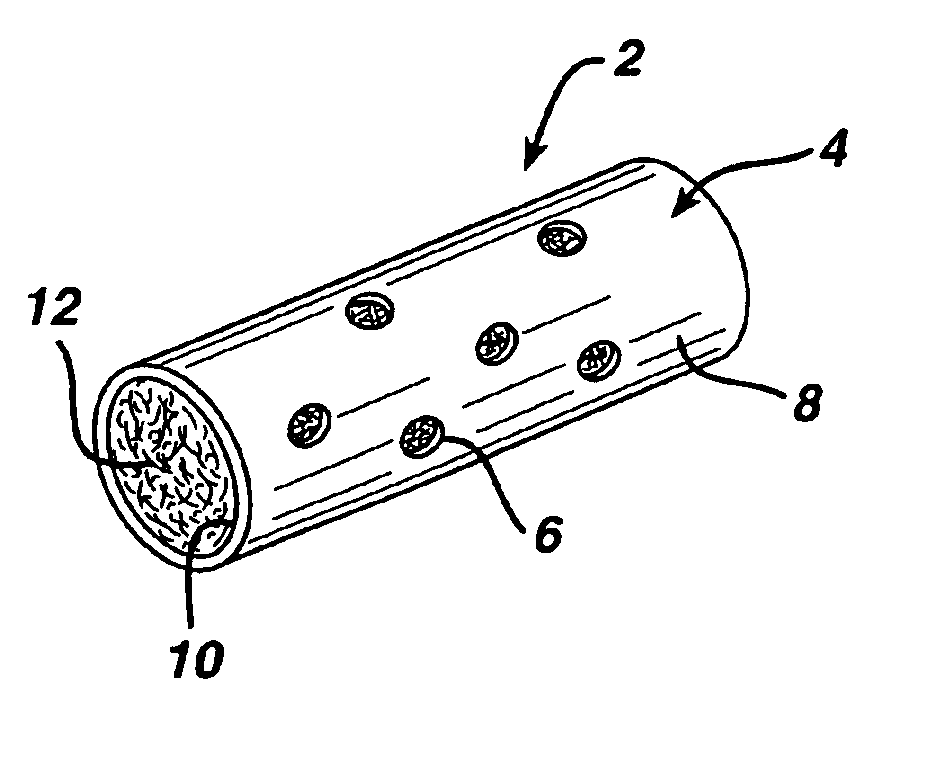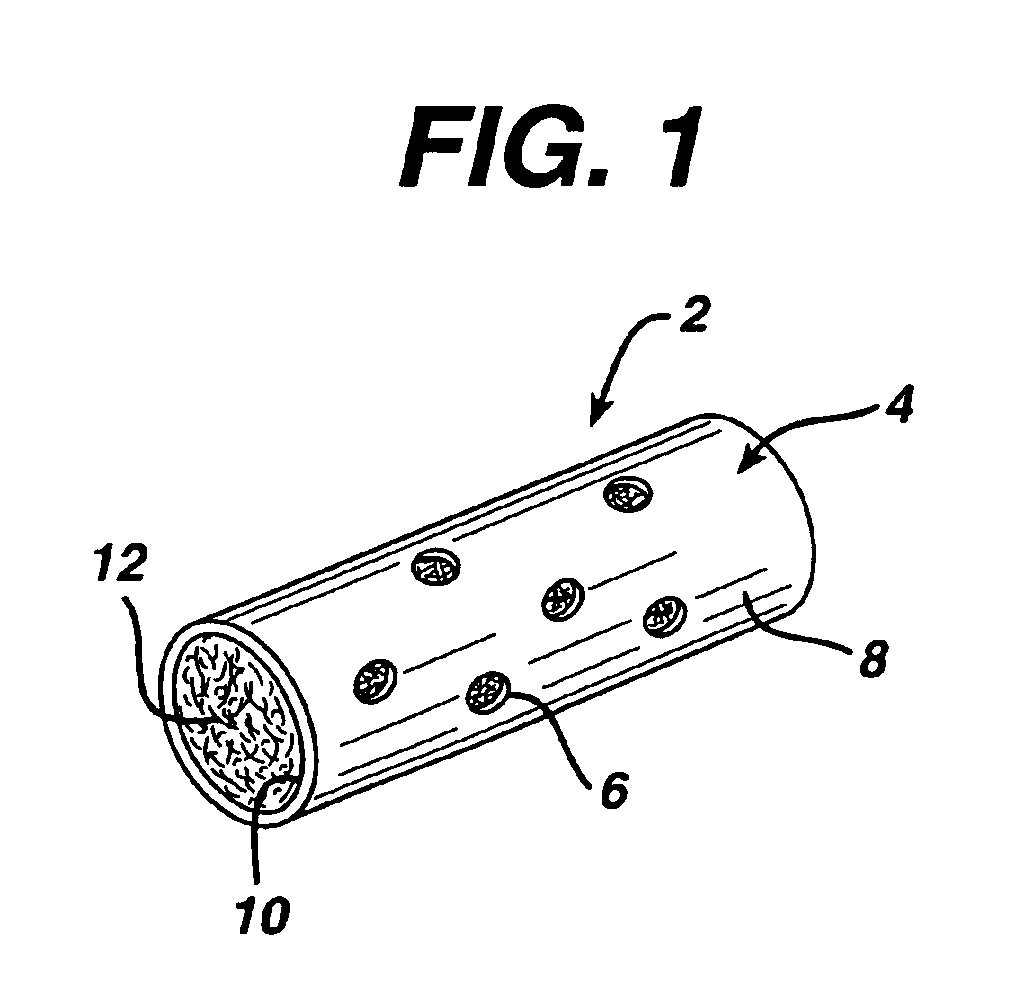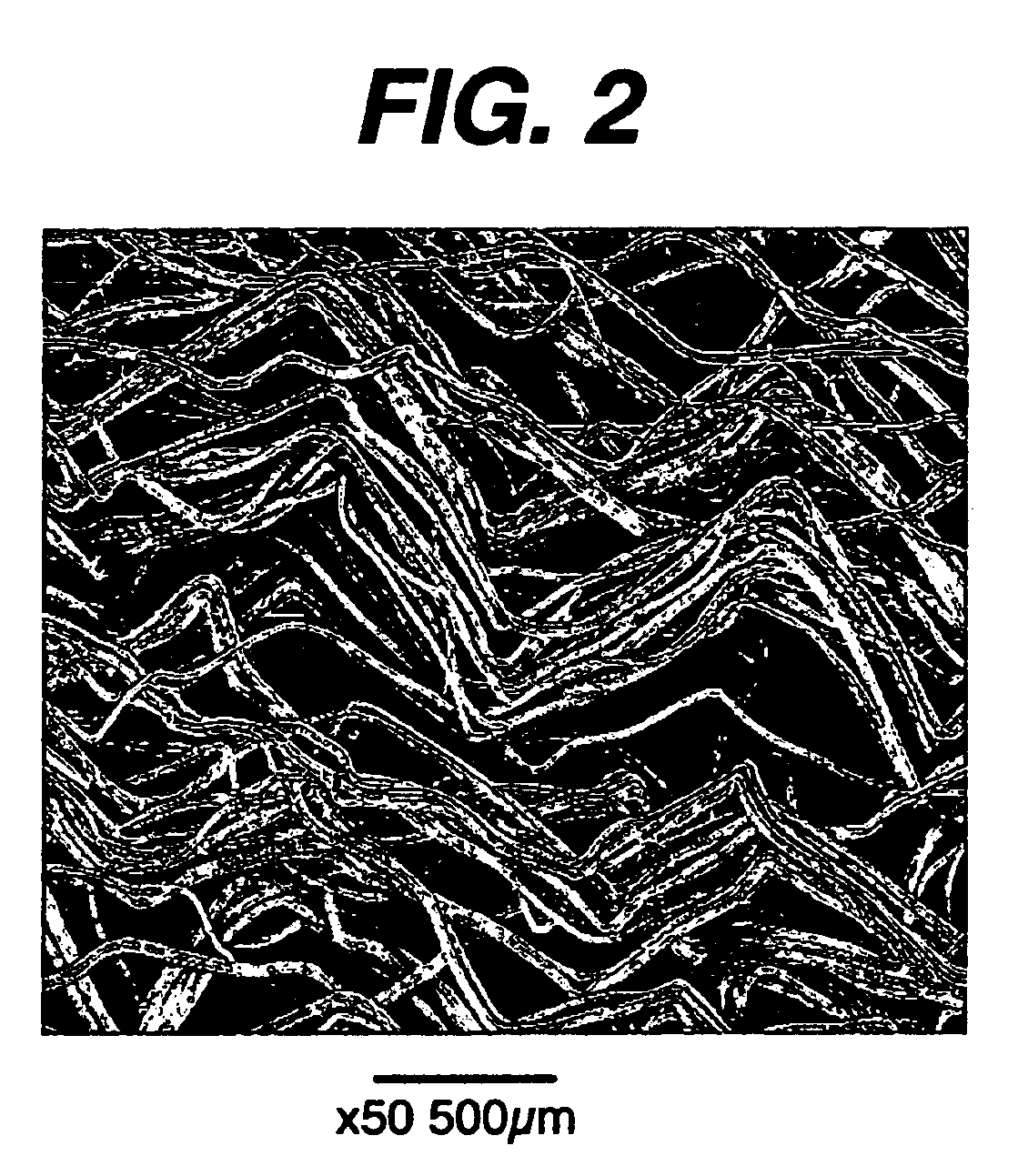Immune modulation device for use in animals
a technology of immune modulation and device, which is applied in the field of immunomodulation device for use in animals, can solve the problems of affecting the diffusion of soluble molecules out of the device, and achieve the effects of enhancing immune response, facilitating miniaturization of the device, and reducing irritation
- Summary
- Abstract
- Description
- Claims
- Application Information
AI Technical Summary
Benefits of technology
Problems solved by technology
Method used
Image
Examples
example 1
Textured Fibrous Filling
[0049]Fiber texturing was performed using a Techtex® HDC10 texturizer (Techniservice, 738 West Cypress Street, Kennett Square, Pa. 19348-0817). Nine spools of 56 denier natural 90 / 10 glycolide-co-lactide (IV of about 1.1 deciliters per gram (dl / g) as measured in a 0.1 g / dl solution of hexafluoroisopropanol at 25° C. The filaments had been drawn about 5× (original length compared to final length). The filaments were placed on the creel and combined into a single 504 denier tow by running the drawn yarns together through a common eyelet. The individual yarn filament diameters were between 12-20 μm. A pretension of 5-7 grams was used for each yarn by passing them through the gate tensioner. The large yarn tow was then passed over a heated godet with the separator roller (15 wraps) with the heated godet being set to a temperature of 130° C. This yarn tow was then fed into the stuffer box by two crimper rolls. The clearance between the stuffer box and rollers was ...
example 2
Membrane Formation
[0050]Membranes were formed from both poly(para-dioxanone) (PDO) and a copolymer of 35 / 65 epsilon-caprolactone / glycolide (CAP / GLY). The inherent viscosity (dl / g) of the PDO and CAP / GLY, as measured in a 0.1 g / dl solution of hexafluoroisopropanol (HFIP) 25° C., were 1.80 and 1.30, respectively. All membranes were formed by extrusion using a ¾-inch Brabender single-screw extruder (C.W. Brabender® Instruments, Inc., So. Hackensack, N.J.) under flowing nitrogen. Membranes with several inner and outer dimensions were formed. Extrusion conditions for the extruded membranes are shown in Table 1. Immediately following exit from the die, all membranes were run through a 12-foot cooling trough filled with chilled water at a temperature of 5-10° C. For the CAP / GLY membranes, short segments (˜2-3 ft.) were cut and hung from one end at room temperature to allow solidification and crystallization of the polymer.
[0051]
TABLE 1Extrusion conditionsDie sizeScrewTake-Die × tipTzone1Tz...
example 3
VLN Construct Formation
[0054]The textured fiber filling from Example 1 was placed inside the membranes discussed in Example 2 as follows. Textured fiber was attached to a small needle or thin filament of wire and pulled through the membrane. The fiber was cut to the length of the membrane. Available porosity was calculated from the volume of the inner lumen of the membrane, weight of textured yarn placed inside of the membrane, and the density of the fibers used. Table 3 shows several of the construct geometries and resultant porosities.
[0055]
TABLE 3Absorbable VLN constructs containing textured fiber.MembraneOD / ID / lengthHole diameter#Fiber weight˜PercentComposition(mm / mm / mm)(μm)holes(mg)porositySample #CAP / GLY2.0 / 1.5 / 25300201280%1CAP / GLY2.0 / 1.5 / 20300161080%2CAP / GLY2.0 / 1.5 / 20300121080%3CAP / GLY2.0 / 1.5 / 2030081080%4CAP / GLY2.0 / 1.5 / 2030041080%5CAP / GLY2.0 / 1.5 / 20not applicable01080%6CAP / GLY2.0 / 1.5 / 25300161083%7CAP / GLY2.0 / 1.5 / 25300161575%8CAP / GLY2.0 / 1.5 / 2030020883%9CAP / GLY2.0 / 1.5 / 20300201275...
PUM
| Property | Measurement | Unit |
|---|---|---|
| porosity | aaaaa | aaaaa |
| diameter | aaaaa | aaaaa |
| outer diameter | aaaaa | aaaaa |
Abstract
Description
Claims
Application Information
 Login to View More
Login to View More - R&D
- Intellectual Property
- Life Sciences
- Materials
- Tech Scout
- Unparalleled Data Quality
- Higher Quality Content
- 60% Fewer Hallucinations
Browse by: Latest US Patents, China's latest patents, Technical Efficacy Thesaurus, Application Domain, Technology Topic, Popular Technical Reports.
© 2025 PatSnap. All rights reserved.Legal|Privacy policy|Modern Slavery Act Transparency Statement|Sitemap|About US| Contact US: help@patsnap.com



